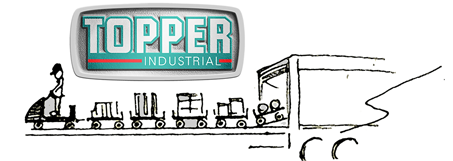Three types of forces combine to resist turning according to MHI, in conjunction with Ergoweb. The detailed research reviewed the ergonomics of material handling and identified a number of key factors that must be considered when designing manual pushing and pulling tasks.
There was a detailed examination of industrial carts and the friction in the swivel housing and at the wheel-ground contact point; inertial forces due to acceleration applied in the turning direction; and any physical interference that may be present at the wheel-ground interface. When the cart is in motion, and a turn is initiated over some arcing distance, the inertial forces are restricted to how much acceleration the operator applies in the new direction. When performing fine positioning, which is often a series of stops and starts, the inertial forces may have a greater effect due to the accelerations and decelerations inherent in these motions.
Friction at the floor (or in the swivel housing for inferior or poorly maintained casters), while the wheel surface pivots on the floor, can add considerable force to a turning or positioning task. A smaller diameter wheel, or a compliant wheel that “flattens” somewhat under the weight of the load, will have a larger contact area than a large diameter, or hard wheel material. The smaller the contact area, the lower the resistance as the wheel pivots in place. A compliant wheel that has a large contact area under loaded conditions is sometimes said to “stick” or “grip” the floor if it is pivoted in place.
Manufacturers design casters with an offset to reduce the force required to turn and swivel. The offset design, meaning the wheel is laterally offset from the point where the caster housing connects to the equipment, provides a horizontal lever arm between the equipment and the point where the wheel contacts the ground. Without this offset, a swivel caster would not swivel unless the equipment was moved in an arc. With the offset lever arm, a horizontal force applied to the equipment acts through the lever arm to pivot the wheel with much greater ease and with a much smaller arc of travel. When fine positioning a piece of equipment, the small travel arcs are very desirable.
According to Ed Brown, the rationale for four or six wheel industrial carts can be easily explained, “The advantages the four wheel industrial carts include a high push-pull force, less expensive option, and a wider turning radius, however the six wheel industrial cart provides a lower push-pull force, tracks better than a four wheel cart, better maneuverability, and provides turning point at middle wheels.”
Given the friction, choosing the best caster and best carts impact the longevity and maintenance of equipment. Too often purchasing professionals look only at the initial purchase price, ignoring the cost of maintenance. For this reason, Topper Industrial carts are not the least expensive purchase solution. The company, always ranked as best-in-class industrial carts, believes the quality of the caster matters in the long-term productivity and quality of the industrial cart, whether four wheels or six.

Posted by Jillian Burrow, Marketing Manager for Topper Industrial – Material Handling Solutions


No Comments Yet!
You can be first to comment this post!